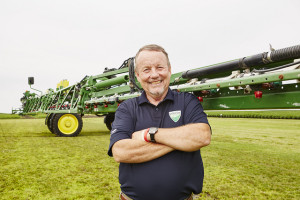Industry News, Agriculture & Feed, Adjuvants
Adjuvant Action Heats Up

Industry News, Agriculture & Feed, Adjuvants

You might say that things have gotten complicated in the adjuvant world. The regulatory issues affecting this already complex segment look decidedly gray — black-and-white would be too easy in agchem.

Dr. Bob Wolf © Agribusinessglobal.com
“Growers won’t be able to freelance products in the tank. They are going to have to use scrutiny,” says Dr. Bob Wolf, a veteran application specialist and consultant based in Illinois. “(U.S. Environmental Protection Agency) is looking into every possible environmental concern they have.”
At the same time, the market is packed with notable product developments and trends that deserve attention.
What is driving the adjuvant industry this year, to be sure, are the long-anticipated new technologies from the Big 3: Dow AgroSciences’ Enlist Duo, Monsanto’s Xtend, and BASF’s Engenia chemistry. Reducing drift is a huge focus.
“The adjuvant companies need to make sure their products are tried and true and tested with these technologies,” says Joe Brennan, Product Development Manager with Atlantic-Pacific Agricultural. “The distributors we work with expect our product, Hook, to work with these herbicide technologies, because that’s what coming down the pipe. It’s a big deal.”
Manufacturers, in many cases, have devoted years to developing adjuvants specifically geared for use with the respective 2,4-D- and dicamba-tolerant systems. All await regulatory approval for tank-mixing with those systems, and questions linger around how EPA will handle label wording bearing in mind the limitless combinations of adjuvants and actives that could go in the tank.
Weed resistance itself is both propelling and complicating the adjuvant market, as growers increase tank-mixing and use of combination products.
“Getting that adjuvant recommendation is becoming more challenging,” says Adam Arellano, Product Manager with Loveland Products. “When Roundup Ready came out it was easier to pick an adjuvant. Now with weed resistance being an issue and new tank mixes on the chemistry side, education is important. You have to know what adjuvants to use in what tank mixes.”

Adam Arellano © Agribusinessglobal.com
Joe Gednalske, Director of Crop Protection Product Development with WinField, calls attention to the point that herbicides require an adjuvant to maximize uptake, whether weeds are resistant or not.
“Putting a high-quality adjuvant can change weed control by 5% to 10%, easily, with many herbicides, and with some significantly more than that,” he says.
With variable carrier volumes sprayed and with the pressure on growers and retailers to cover so much ground so rapidly, they’re often driving sprayers too fast, in many cases utilizing too low of spray volumes, so the value of adjuvants is often even greater than what is seen in small-plot research, Gednalske says. “It’s a critical piece that people overlook. In non-ideal situations, adjuvants pay huge dividends.”
Moreover, he adds, manufacturers, dealers, and growers need to optimize weed control to prevent resistance to the new technologies. “Dicamba and the 2,4-D traits are the last thing for quite a while to fight resistant weeds, so we’d better take advantage of them, and not allow resistant weeds to form around these — otherwise we will have real issues. There is no other silver bullet waiting. We’d better do this right.”
No products are yet approved for use with the Big 3’s new systems, but here is a look at some of the ones to watch.
WinField has developed Class Act Ridion, a non-ammonium sulfate (AMS) water conditioner containing its CornSorb technology for improved herbicide uptake. Removal of the ammonium sulfate is aimed at minimizing dicamba volatility, a big emphasis for BASF and Monsanto.
Loveland Products has also created a pair of products with these systems in mind. The major offering is Strike Force, its all-in-one convenience adjuvant based in the company’s Leci-Tech technology, which aids in drift, penetration, spreading, and adhesion, and contains a defoaming agent and non-AMS water conditioner as well. Loveland launched the product last year and has already seen great acceptance in certain markets, according to Arellano. It is also offering a standalone non-AMS water conditioner called Choice Trio.
“With the dicamba technologies, pH was something to keep an eye on, as well as drift and volatility, so as we developed these adjuvants we made sure we were working hand-in-hand with these companies to make sure the products fit in line with the new technologies,” Arellano says.
Atlantic-Pacific Agricultural is banking on its all-in-one product, Hook, for use with the new technologies, as growers seek to save time and money with multi-functional products. Brennan says the company has done extensive wind tunnel testing with Hook in combination with the new herbicide technology formulations, and the results show “very positive impact” for drift reduction and droplet size optimization.
Riding the drift reduction technology trend, Helena Products Group launched its Justified adjuvant in the past year. The product, which Terry Nash, Helena’s Manager of Adjuvant Brands, says has been well-accepted in the marketplace, increases droplet size and reduces driftable fines for a lower risk of off-target drift.
“What is unique about this product is that usually oils to get drift reduction need to be used at a 1% volume-to-volume rate. With (Justified) you can use it down to 0.25%, so it’s a very low use rate,” Nash adds. The company is also looking at non-AMS water conditioners to be used with the new technologies, as well as a brand new activator technology that it began field-testing last year which Nash says has promise.
Wilbur-Ellis has been focusing on building its Eco-Advantage platform, and has been taking the nonylphenol ethoxylates (NPEs) out of its chemistries due to toxicity concerns in export markets, says Terry Abbott, Adjuvant Branded Product Manager. It started out with two products in the platform in 2014 and will soon have six, including Rainier-EA, a non-ionic surfactant, which has shown to boost herbicide efficacy by up to 20% over current standards. The company has also recently launched Denali-EA, an acidifier-buffering non-ionic surfactant.
“(Consumers) are calling for more eco-friendly products, and that’s where we fit in. Nobody in this industry is doing what we’re doing,” Abbott says.
Everyone we spoke with affirmed that adjuvants are a necessary component of ensuring herbicide efficacy. However, added costs that are perceived as potentially optional stand to be cut this year by some growers, which could be a boon for commodity-based adjuvants. It’s basically this: After a seven-year red-hot streak in ag, reality is hitting.
“We’re already hearing growers are being turned down for financing. Financing is a concern for all of us this year with low commodity prices,” Nash says.
The overriding message, though, is that skimping on adjuvants means yields will be sacrificed for pennies saved.
Dr. Greg Kruger, Assistant Professor and Cropping Systems Specialist at the University of Nebraska-Lincoln, says he doesn’t encourage anyone to cut corners on adjuvants. “It’s like going to a restaurant and ordering food but not the plate.”
Nash adds: “Farmers are going to do what they traditionally do. They can’t leave that land idle. They’ve got fixed costs, and they still have to pay taxes. What we’re trying to do is look at ways to help the grower control costs but not cut back on production, and the only way to make up for that is to get more yield.”
Arellano adds that even with $3.75 per bushel of corn, a grower is still trying to make a living. “They’re still going to want to make that acre profitable. If they see value, for example with our Leci-Tech product versus the standard 80/20 surfactant, particularly for adjuvants it’s a small price difference on that acre spend for a grower to ensure better performance.”